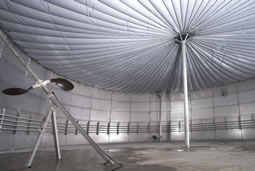The bio-gas plant manufacturer WELtec BioPower GmbH of Vechta, Germany was granted a construction permit to build the world's largest bio-gas plant, which will feed the bio-gas it produces directly into Germany's natural gas network.
 (01.06.2010) Together with some 30 farmers from the area surrounding the 8000-resident town of Könnern, the plant will produce some 30 million cubic meters of raw bio-gas per year. Some 15 million cubic meters of bio-methane can be produced in the bio-gas park between the cities of Halle and Magdeburg. The facility will ferment just over 120,000 tons of substrate annually. "The construction permit signals the beginning of the most ambitious project to date in our company's history," emphasized Jens Albartus, the company CEO. The substrates will consist mainly of renewable resources, such as feed corn, whole-plant ensilage (wheat and rye), as well as liquid cow and pig manure, alfalfa, and Sudan grass.
(01.06.2010) Together with some 30 farmers from the area surrounding the 8000-resident town of Könnern, the plant will produce some 30 million cubic meters of raw bio-gas per year. Some 15 million cubic meters of bio-methane can be produced in the bio-gas park between the cities of Halle and Magdeburg. The facility will ferment just over 120,000 tons of substrate annually. "The construction permit signals the beginning of the most ambitious project to date in our company's history," emphasized Jens Albartus, the company CEO. The substrates will consist mainly of renewable resources, such as feed corn, whole-plant ensilage (wheat and rye), as well as liquid cow and pig manure, alfalfa, and Sudan grass. | Copyright: | © Deutscher Fachverlag (DFV) |
| Quelle: | Entsorga China 01_2010 (Juni 2010) |
| Seiten: | 1 |
| Preis: | € 0,00 |
| Autor: | Thomas Wilkens |
| Artikel nach Login kostenfrei anzeigen | |
| Artikel weiterempfehlen | |
| Artikel nach Login kommentieren | |
Europäische Rechtsvorgaben und Auswirkungen auf die Bioabfallwirtschaft in Deutschland
© Witzenhausen-Institut für Abfall, Umwelt und Energie GmbH (11/2025)
Bioabfälle machen 34 % der Siedlungsabfälle aus und bilden damit die größte Abfallfraktion im Siedlungsabfall in der EU. Rund 40 Millionen Tonnen Bioabfälle werden jährlich in der EU getrennt gesammelt und in ca. 4.500 Kompostierungs- und Vergärungsanlagen behandelt.
Vom Gärrest zum hochwertigen Gärprodukt - eine Einführung
© Witzenhausen-Institut für Abfall, Umwelt und Energie GmbH (11/2025)
Auch mittel- bis langfristig steht zu erwarten, dass die Kaskade aus anaerober und aerober Behandlung Standard für die Biogutbehandlung sein wird.
Die Mischung macht‘s - Der Gärrestmischer in der Praxis
© Witzenhausen-Institut für Abfall, Umwelt und Energie GmbH (11/2025)
Zur Nachbehandlung von Gärrest aus Bio- und Restabfall entwickelte Eggersmann den Gärrestmischer, der aus Gärresten und Zuschlagstoffen homogene, gut belüftbare Mischungen erzeugt. Damit wird den besonderen Anforderungen der Gärreste mit hohem Wassergehalt begegnet und eine effiziente Kompostierung ermöglicht.